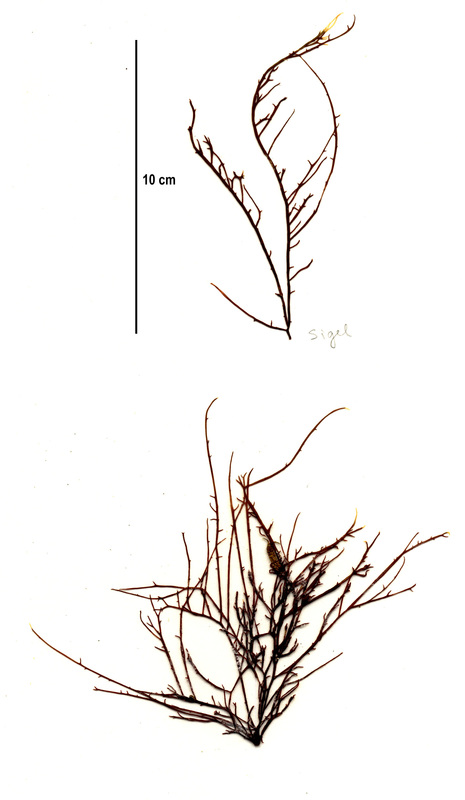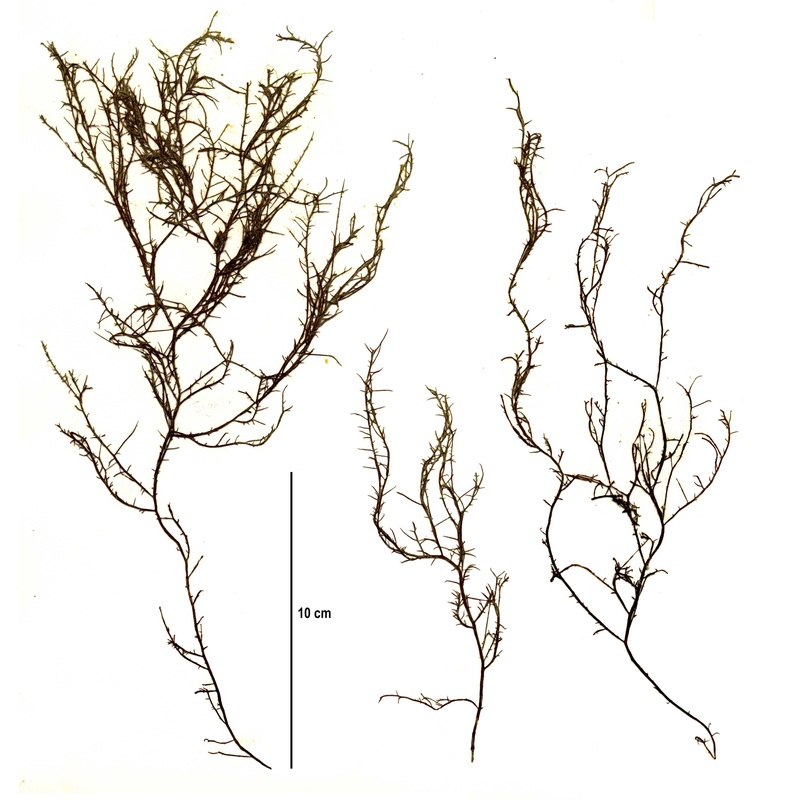California limu, red spaghetti • Gracilaria pacifica, G. verrucosa
|
Specimen collection numbers SCL 15371 (left) and SCL 15384 in the UBC Herbarium Algae Databse. Search the collection number in the database for more information on this specimen, or search the species for further occurrences. Images courtesy of Sandra Lindstrom.
|
Identification
This red alga has long and thin cylindrical branches; it reaches 50 cm tall and only 2 mm wide. It is sparsely branched, often with small spiny branches around the bases of the main axes. Its colour is reddish-brown to brown. Carposporophytes form small bumps along the branches.
Habitat & Range
Gracliaria species usually grow in the subtidal of sheltered shorelines. California limu is found from the mid intertidal to shallow subtidal of protected areas, and ranges from Alaska to northern Mexico. It commonly grows on rocks partially buried in mud.
Similar Species
Species belonging to the Gracilariopsis and Gracilaria genera can be extremely difficult to differentiate and microscopic examination is usually required for a correct identification - though habitat can be helpful as the former is more commonly found in moderately exposed to exposed intertidal locations. An example of a similar species also found on the Central Coast is sea spaghetti (Gracilariopsis andersonii), which reaches 2 m in length and grows in more exposed habitats.
Human Uses
This species is edible, and is a source of the jelly-like thickening agent agar.
This red alga has long and thin cylindrical branches; it reaches 50 cm tall and only 2 mm wide. It is sparsely branched, often with small spiny branches around the bases of the main axes. Its colour is reddish-brown to brown. Carposporophytes form small bumps along the branches.
Habitat & Range
Gracliaria species usually grow in the subtidal of sheltered shorelines. California limu is found from the mid intertidal to shallow subtidal of protected areas, and ranges from Alaska to northern Mexico. It commonly grows on rocks partially buried in mud.
Similar Species
Species belonging to the Gracilariopsis and Gracilaria genera can be extremely difficult to differentiate and microscopic examination is usually required for a correct identification - though habitat can be helpful as the former is more commonly found in moderately exposed to exposed intertidal locations. An example of a similar species also found on the Central Coast is sea spaghetti (Gracilariopsis andersonii), which reaches 2 m in length and grows in more exposed habitats.
Human Uses
This species is edible, and is a source of the jelly-like thickening agent agar.
References
Druehl, L. 2000. Pacific Seaweeds: A guide to common seaweeds of the west coast. Harbour Publishing: Madeira Park, BC, Canada. Pp. 126.
Lamb, A., and Hanby, B. (2005). Marine Life of the Pacific Northwest [electronic version]. Madeira Park, BC: Harbour Publishing.
O'Clair, R. and Lindstrom, S. Gracilaria pacifica Abbott 1985. In Klinkenberg, Brian. (Ed.). E-Flora BC: Electronic Atlas of the Plants of British Columbia. Lab for Advanced Spatial Analysis, Department of Geography, University of British Columbia, Vancouver. Accessed 08/06/2015.
Authors and editors of page
Kelly Fretwell and Brian Starzomski (2015).
Druehl, L. 2000. Pacific Seaweeds: A guide to common seaweeds of the west coast. Harbour Publishing: Madeira Park, BC, Canada. Pp. 126.
Lamb, A., and Hanby, B. (2005). Marine Life of the Pacific Northwest [electronic version]. Madeira Park, BC: Harbour Publishing.
O'Clair, R. and Lindstrom, S. Gracilaria pacifica Abbott 1985. In Klinkenberg, Brian. (Ed.). E-Flora BC: Electronic Atlas of the Plants of British Columbia. Lab for Advanced Spatial Analysis, Department of Geography, University of British Columbia, Vancouver. Accessed 08/06/2015.
Authors and editors of page
Kelly Fretwell and Brian Starzomski (2015).





